Next-generation fast rotorcraft are an important cornerstone in achieving Europe’s environmental and mobility objectives, including the target of achieving 90% of door-to-door travel within Europe within four hours. These unique rotary-wing platforms offer vertical take-off and landing capability combined with high-speed and long-range mission performance, providing benefits in passenger air transport and socially relevant missions such as search-and-rescue and emergency medical services. The Leonardo Helicopters Next Generation Civil TiltRotor Technology Demonstrator (NGCTR-TD) is one of two platforms being concurrently developed within the Fast Rotorcraft programme. The ATTILA project, led by Royal Netherlands Aerospace Centre (NLR), is an essential milestone in the future clearance for high-speed flight testing of the NGCTR-TD.
Challenges in dynamics
An aeroelastic instability involving coupled rotor, pylon and wing motion known as proprotor whirl flutter is one of the main drivers in the design of tiltrotor aircraft. This phenomenon typically limits the maximum forward flight speed that can be attained. The mechanical interplay between the wing/proprotor system and the complex aerodynamic environment make numerical prediction of the instability boundary notoriously difficult; experimental characterisation of the flutter behaviour is required for validating the methods employed for the design of the full-scale aircraft. The ATTILA project, which aims to develop and test a powered half-wing wind tunnel model of the NGCTR-TD, will provide the necessary experimental data.
Aeroelastic wind tunnel model design
As the consortium lead, NLR has been responsible for designing and manufacturing the ATTILA testbed and has acted as test director for the final data gathering test campaign. Unlike typical wind tunnel models, which are geometrically scaled, the ATTILA testbed was aeroelastically scaled, meaning that not only the geometry but also both the mass and stiffness of the main structural elements are tailored to reproduce the structural dynamics of the full-scale aircraft at the model scale. The multidisciplinary nature of the design has meant that no fewer than nine NLR departments were involved in the project over a five-year period.
Antonello Marino Team Leader – Hybrid Electric Regional Aircraft at the Clean Aviation Joint Undertaking: “Fully in line with the Horizon 2020 ambition, the ATTILA project allowed the development of new testing capabilities and competencies in Europe around complex and critical aero-elastic phenomena such as whirl-flutter. Implemented in the framework of the Clean Sky 2-Fast Rotorcraft System Demonstrator Platform and specifically contributing to the NGCTR-TD, the project has collected a huge amount of data that now will be carefully analysed by specialists and researchers for many purposes and, among others, it will support the Technology Demonstrator to safely perform flight test activities in 2024.”
Flutter test programme
The wind tunnel test activities, completed in November 2023, were carried out in the 6x6m test section of the DNW Large Low-speed Facility (LLF) wind tunnel in the Netherlands, with support from the German Aerospace Centre (DLR) and Leonardo Helicopters. The Structural Dynamics and System Identification team from DLR Göttingen provided online monitoring and forecasting of the modal properties (frequency and damping) of the testbed, as the instability boundary was incrementally approached during testing. Model piloting and data acquisition were done by a team from DLR Braunschweig, utilising systems and expertise developed over many years of operating experimental rotor systems in wind tunnels. Finally, as test co-directors and experts for tiltrotor dynamics and stability, Leonardo Helicopters guided the definition and execution of the test programme and performed semi-online analysis of the flutter mode frequency and damping trends using well-established industry methods.
Next steps
Following the successful completion of the test programme in November 2023, the consortium is hard at work to post-process the test data and perform initial correlations against numerical predictions. Multiple publications at technical conferences, including the Clean Aviation Forum, are planned in 2024 to disseminate the knowledge gained during the programme. The wealth of data obtained is expected to keep engineers busy for the foreseeable future until the ATTILA testbed can return to the wind tunnel to satisfy future tiltrotor research needs.

About the ATTILA project
Visit the ATTILA project website at https://attila-project.eu
If you would like to know more, check out this page at the NLR website, and get a taste of the test activities through this video. Also note that within the Clean Sky 2 programme’s Fast Rotorcraft Innovative Aircraft Demonstrator Platform (FRC-IADP), two architectures for fast rotorcraft are being developed and will be tested in flight: the NGCTR-TD, as described above, and the Rapid And Cost-Efficient Rotorcraft (RACER) compound rotorcraft demonstrator. For more information about these two different architectures, please see the following links: NGCTR-TD and RACER.
This project has received funding from the Clean Sky 2 Joint Undertaking (JU) research and innovation programme
under grant agreement No 863418.




